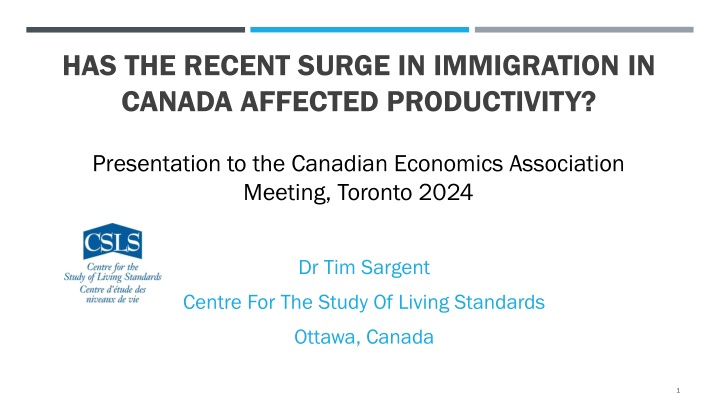
Impact of Immigration Surge on Canadian Productivity 2024 Presentation
Explore the potential effects of the recent surge in immigration on productivity in Canada as discussed by Dr. Tim Sargent at the Canadian Economics Association Meeting in Toronto 2024. The presentation delves into the decline in productivity, growth in employment, population trends, labor quality data, and the implications of immigration shocks on the standard production function, offering insights into the intricate dynamics at play.
Download Presentation

Please find below an Image/Link to download the presentation.
The content on the website is provided AS IS for your information and personal use only. It may not be sold, licensed, or shared on other websites without obtaining consent from the author. If you encounter any issues during the download, it is possible that the publisher has removed the file from their server.
You are allowed to download the files provided on this website for personal or commercial use, subject to the condition that they are used lawfully. All files are the property of their respective owners.
The content on the website is provided AS IS for your information and personal use only. It may not be sold, licensed, or shared on other websites without obtaining consent from the author.
E N D
Presentation Transcript
HAS THE RECENT SURGE IN IMMIGRATION IN CANADA AFFECTED PRODUCTIVITY? Presentation to the Canadian Economics Association Meeting, Toronto 2024 Dr Tim Sargent Centre For The Study Of Living Standards Ottawa, Canada 1
In 2023 productivity declined by 0.9 per cent, as employment grew 2.4 per cent 120 115 110 2015=100 105 100 95 90 2015 2016 2017 2018 2019 2020 2021 2022 2023 Output Employment Output per Person Employed Data are for the Total Economy. Statistics Canada Tables: 36-10-0369-01; 14-10-0023-01. 2
Meanwhile population growth has increased significantly, driven by non-permanent residents 3.5 3.0 2.5 2.0 1.5 1.0 0.5 0.0 2012 2013 2014 2015 2016 2017 2018 2019 2020 2021 2022 2023 -0.5 Permanent Residents Non-Permanent Residents Net Emigration Natural Increase Sources: Statistics Canada Tables 17-10-0009-01, 17-10-0040-01 3
Is there a connection? What does a conventional growth model say? Standard Production Function ? = ? ? ?,?? ??+ ?? ??,? where Q is labour quality and L is labour supply for immigrants (I) and non-immigrants (N) R is natural resources in fixed supply land, mineral deposits etc. Impact of an immigration shock depends on Relative labour quality of immigrants and non-immigrants, and how quickly immigrants catch up (if at all) How quickly capital stock adjusts Importance of natural resources, and how fixed R really is 4
Labour quality Custom data from Labour Force Survey 2006-2023 Data is for employees: gives education and hourly wages for five classes of immigration status: Canadian born Permanent Residents: Very recent < 5 years Recent 5-10 years Established > 10 years Non-permanent residents refers to a person from another country with a usual place of residence in Canada and who has a work or study permit or who has claimed refugee status (asylum claimant). Family members living with work or study permit holders are also included unless these family members are already Canadian citizens, landed immigrants (permanent residents), or non-permanent residents themselves. 5
NPRs were 30% of 2023 employee growth of 2.8% Very recent immigrants were another 15% 8.0 6.0 4.0 2.0 0.0 2015 2016 2017 2018 2019 2020 2021 2022 2023 -2.0 -4.0 -6.0 -8.0 Canadian-born Established (10+) Recent (5-10) Very recent (<5) Non permanent residents Source: Statistics Canada special tabulation from the Labour Force Survey. Numbers are for employees only. 6
NPRs educational attainment similar to recent immigrants 100% 90% 80% 70% 60% 50% 40% 30% 20% 10% 0% Canadian-born Established (10+) Recent (5-10) Very recent (<5) Non permanent residents No credentials High school High school, some PS Post-Secondary Bachelor's Above Bachelor's Source: Statistics Canada special tabulation from the Labour Force Survey. Data are for 2023. 7
Educational attainment for NPRs has not changed much over time Non Permanent Residents 100% 90% 80% 70% 60% 50% 40% 30% 20% 10% 0% 2012 2013 2014 2015 2016 2017 2018 2019 2020 2021 2022 2023 No credentials High school High school, some PS Post-Secondary Bachelor's Above Bachelor's Source: Statistics Canada special tabulation from the Labour Force Survey 8
Wages of NPRs have fallen significantly relative to the Canadian-born, whereas wages of very recent immigrants have risen 110 105 100 95 90 85 80 75 70 2006 2007 2008 2009 2010 2011 2012 2013 2014 2015 2016 2017 2018 2019 2020 2021 2022 2023 Established (10+) Recent (5-10) Very recent (<5) Non permanent residents Source: Statistics Canada special tabulation from the Labour Force Survey 9
Wage differential highest for the most educated NPRs 120 110 Relative to Canadian-born 100 90 80 70 60 2006 2007 2008 2009 2010 2011 2012 2013 2014 2015 2016 2017 2018 2019 2020 2021 2022 2023 No credentials High school Post-Secondary Bachelor's Above Bachelor's Source: Statistics Canada special tabulation from the Labour Force Survey. Note: Wage differential is relative to Canadian-born in each category 10
What is the material impact of changes in proportion of immigrants and change in wage differentials? Perform a shift-share analysis Impact of group i on wages is ?? ?? + ?? ?? where ?? is wage differential with average wages and ?? is the share in total employment Two components: ?? ?? is the impact of a change in composition holding wage differentials constant ?? ?? is the impact of a change in the wage differential holding composition constant In practice the change in wage differential may also be picking up compositional effects 11
For NPRs, increase in share and decline in relative wages reduced wage growth by 0.28 pps; for very recent immigrants only 0.05 pps Non-permanent residents Very recent immigrants 0.15 0.15 0.10 0.10 0.05 0.05 0.00 0.00 -0.05 -0.05 -0.10 -0.10 -0.15 -0.15 -0.20 -0.20 -0.25 -0.25 -0.30 -0.30 -0.35 -0.35 2016 2017 2018 2019 2020 2021 2022 2023 2016 2017 2018 2019 2020 2021 2022 2023 Impact due to change in share Impact due to change in relative wages Impact due to change in share Impact due to change in relative wages Source: Statistics Canada special tabulation from the Labour Force Survey 12
What is the impact of faster population growth on productivity in a standard Solow model of growth? Standard Solow Model ??= ?? ??? ?? 1 ? ??+1 ??= ? ?? ?? where sis the (exogenous) investment rate and is the depreciation rate Define g as growth of TFP and n as the growth of employment. 1 p.p. increase in employment growth leads to percentage change in K/L as follows: Initial Impact Initial Impact Long Run Impact Long Run Impact Temporary Permanent ? ? 0 ? 1 1 ? ? + ? + ? 13
Dynamics of Solow Model Capital-Labour Ratio ??= ??/?? Then ?? converges to steady state ?? according to the equation ??= ? + ? (?? ??) where ? = (1 ?) (? + ? + ?) Convergence will be slower when Capital stock big relative to the economy (? is large) Depreciation is low (? is low) and capital stock turns over slowly This is the well-known conditional convergence equation that has been estimated empirically many times (e.g. Barro 1991) Cross-country evidence tends to find that convergence is slower than predicted by the Solow model: therefore should be seen as an upper bound 14
Labours Share was 57.0 per cent in 2023 Depreciation Rate was 7.8 per cent in 2023 35 62 60.0 29.4 30 60 59.2 23.5 25 58 57.0 20 56 15 12.4 54 10 8.1 7.8 7.7 52 51.1 3.6 5 50 0 48 46 Employees Employees plus 2/3 of Mixed Income Employees plus Net Mixed Income Employees plus 2/3 of Net Mixed Income Source: Statistics Canada Table 34-10-0163-01 Source: Statistics Canada Table 36-10-0103-01 15
Simulation suggests increase in NPR employees that increased employment by 0.7 percentage points in 2023, reduced productivity growth by 0.31 percentage points Level Impacts Growth Impacts 0.80 0.80 0.60 0.60 0.40 0.40 0.20 0.20 0.00 0.00 2023 2024 2025 2026 2027 2028 2029 2030 2023 2024 2025 2026 2027 2028 2029 2030 -0.20 -0.20 -0.21 -0.31 -0.31 -0.40 -0.40 Output Labour Productivity Output Labour Productivity Note: Simulation of Solow model with lambda = 0.054 16
Summary of Results Increase in NPRs in 2023 has had a negative impact on productivity through two channels Reduced labour quality: 0.28 percentage points Lower capital-labour ratio: -0.31 percentage points Total impact: -0.59 percentage points. Explains two-thirds of the decline in output per worker in 2023 Long run impacts: depends on whether proportion of NPRs continues to go up, or whether it goes down remember, supposed to be Non Non-permanent If proportion stabilizes (so employment of NPRs grows at same rate as average), then Good news: impact on productivity level will dissipate as Capital-Labour Ratio returns to trend NPRs become permanent residents and catch up to wage rates of established immigrants (assuming that their experience is similar to PRs) Bad news: transition is long Takes 13 years for half of impact on capital-labour ratio to unwind PRs who have been in Canada 5-10 years still have wages almost 10 per cent below average 17
Caveats How good is Statistics Canada at capturing immigrants, especially NPRs? Data from IRCC may be missing overstays LFS population of working age data show slower growth than population growth data Data are for employment not hours Could be more part time workers among NPRs, especially students Do wages reflect productivity? NPRs might be cheaper because work a pathway to Permanent Residency for many Although in a competitive labour market this should be bid away by employers What about resource and land rents? About half of fixed assets Share of income likely around 5-10 per cent Not likely to make a big difference in short-medium run as produced capital is slow-moving 18






















